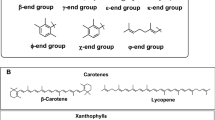Abstract
Recently we isolated the purple photosynthetic bacterium, Rhodopseudomonas sp. Rits, which was phylogenetically related to Rhodopseudomonas (Rps.) palustris. In this study, the light-dependent and time-dependent changes in the carotenoid composition were investigated by HPLC analysis of extracts from the cultures. All seven carotenoids in the biosynthetic pathway from lycopene to spirilloxanthin were detected. Especially, 3,4-didehydrorhodopin, having twelve conjugated double bonds as well as one terminal hydroxy group, was isolated in a remarkably large amount and fully characterized for the first time. The biosynthetic intermediate was commonly found in the Rps. palustris strains (CGA009, Morita and NBRC100419).
Similar content being viewed by others
References
R. J. Cogdell, A. Gall, J. Köhler, The architecture and function of the light-harvesting apparatus of purple bacteria: from single molecules to in vivo membranes, Quarterly Rev. Biophys., 2006, 39, 227–324.
H. P. Lang, C. N. Hunter, The relationship between carotenoid biosynthesis and the assembly of the light-harvesting LH2 complex in Rhodobacter sphaeroides, Biochem. J., 1994, 298, 197–205.
H. A. Frank and R. J. Cogdell, The photochemistry and function of carotenoids in photosynthesis, in Carotenoids in Photosynthesis, ed. A. Young, and G. Britton, Chapman & Hall, London, 1993, pp. 252–326.
K. Schmidt, Biosynthesis of carotenoids, in The Photosynthetic Bacteria, ed. R. K. Clayton and W. R. Sistrom, Plenum Press, New York, 1978, pp. 729–750.
R. U. Schwerzmann, R. Bachofen, Carotenoid profiles in pigment-protein complexes of Rhodospirillum rubrum, Plant Cell Physiol., 1989, 30, 497–504.
P. Qian, K. Saiki, T. Mizoguchi, K. Hara, T. Sashima, R. Fujii, Y. Koyama, Time-dependent changes in the carotenoid composition and preferential binding of spirilloxanthin to the reaction center and anhydrorhodovibrin to the LH1 antenna complex in Rhodobium marinum, Photochem. Photobiol., 2001, 74, 444–452.
A. Gall, S. Henry, S. Takaichi, B. Robert, R. J. Cogdell, Preferential incorporation of coloured-carotenoids occurs in the LH2 complexes from non-sulfur purple bacteria under carotenoid-limiting conditions, Photosynth. Res., 2005, 86, 25–35.
S. Takaichi, Carotenoids and carotenogenesis in anoxygenic photosynthetic bacteria, in The Photochemistry of Carotenoids, ed. H. A. Frank, A. J. Young, G. Britton and R. J. Cogdell, Kluwer Academic Publishers, The Netherlands, 1999, pp. 39–69.
J. Harada, T. Mizoguchi, S. Yoshida, M. Isaji, H. Oh-oka, H. Tamiaki, Compositional and localization of bacteriochlorophyll a intermediates in the purple photosynthetic bacterium Rhodopseudomonas sp. Rits, Photosynth. Res., 2008, 95, 213–221.
H. Hayashi, M. Miyao, S. Morita, Absorption and fluorescence spectra of light-harvesting bacteriochlorophyll–protein complexes from Rhodopseudomonas palustris in the near-infrared region, J. Biochem., 1982, 91, 1017–1027.
M. B. Evans, A. M. Hawthornthwaite, R. J. Cogdell, Isolation and characterization of the different B800–850 light-harvesting complexes from low- and high-light grown cells of Rhodopseudomonas palustris, strain 2.1.6, Biochim. Biophys. Acta, 1990, 1016, 71–76.
N. Hartigan, H. A. Tharia, F. Sweeney, A. M. Lawless, M. Z. Papiz, The 7.5-Å electron density and spectroscopic properties of a novel low-light B800 LH2 from Rhodopseudomonas palustris, Biophys. J., 2002, 82, 963–977.
T. Mizoguchi, J. Harada, H. Tamiaki, Structural determination of dihydro- and tetrahydrogeranylgeranyl groups at the 17-propionate of bacteriochlorophylls- a, FEBS Lett., 2006, 580, 6644–6648.
K. V. P. Nagashima, K. Shimada, K. Matsuura, Shortcut of the photosynthetic electron transfer in a mutant lacking the reaction center-bound cytochrome subunit by gene disruption in a purple bacterium, Rubrivivax gelatinosus, FEBS Lett., 1996, 385, 209–213.
G. Britton, UV/visible spectroscopy, in Carotenoids, ed. G. Britton, S. Liaaen-Jensen and H. Pfander, Birkhäuser, Basel, 1995, vol. 1B, pp. 13–62.
T. Maoka, N. Akimoto, K. Hashimoto, Rapid on-line analysis of natural carotenoids by combined HPLC, UV-Vis and MS, Foods & Food Ingredients J. Jpn., 2003, 208, 623–630.
Y. Koyama, M. Hosomi, H. Hashimoto, T. Shimamura, 1H NMR spectra of the all-trans, 7-cis, 9-cis, 13-cis and 15-cis isomers of β-carotene: elongation of the double bond and shortening of the single bond toward the center of the conjugated chain as revealed by vicinal coupling constants, J. Mol. Struct., 1989, 193, 185–201.
Author information
Authors and Affiliations
Corresponding author
Additional information
Electronic supplementary information (ESI) available: Details of the mass spectral analysis, electronic-absorption properties of each carotenoid found in Rhodopseudomonas sp. Rits and1H-NMR data of the isolated 3,4-didehydrorhodopin. See DOI: 10.1039/b719272j
Rights and permissions
About this article
Cite this article
Mizoguchi, T., Isaji, M., Harada, J. et al. Identification of 3,4-didehydrorhodopin as major carotenoid in Rhodopseudomonas species. Photochem Photobiol Sci 7, 492–497 (2008). https://doi.org/10.1039/b719272j
Received:
Accepted:
Published:
Issue Date:
DOI: https://doi.org/10.1039/b719272j




